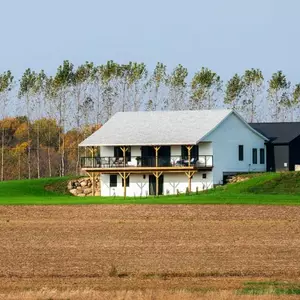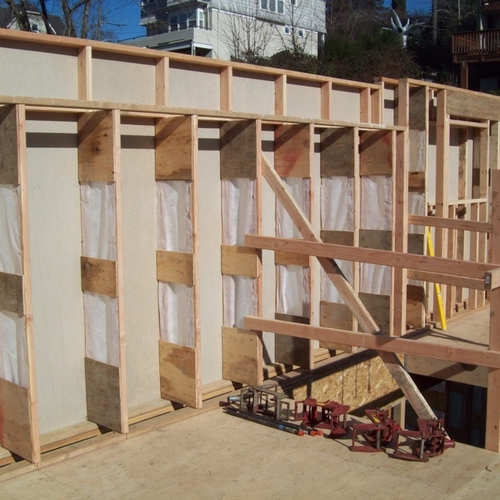
I try to avoid working on weekends, but this past Sunday I found myself helping to install a $5000 TV on the wall of a $1.8 million house. The home automation guy hired me to cut and patch drywall so he could move the existing speakers. That’s not my usual line of work, but he’s a good guy and a great business contact, which explains why I was working and not out mountain biking like my friends were that morning.
The lot is a secluded one halfway back a dusty, steep, one-lane dirt road that I’ve actually sweated up on my bike. The house’s design is reminiscent of a barn. The 600-square-foot great room has 20-foot ceilings outlined with salvaged barn beams arrayed around the room to make it look like it had once, perhaps, stored hay. The trim was made from old barn siding. All three floors were similarly appointed, one, evidently, for each of the home’s occupants.
The flooring was just darkly stained #2 pine shiplap face-nailed with square-cut nails. The handrails were everyday 6010 colonial red oak you can buy at Home Depot. The trim execution wasn’t as good as I used to do in vinyl-sided spec houses in New Jersey. And I can do a better job finishing drywall than whoever did it in this house, which is saying something.
Taking out the first speaker, I found that it had been recessed into a triple stud. About 2/3 of the wood had been removed by whoever put in the previous big TV. In 40 years in the trades, I must have encountered at least one triple stud that wasn’t doing something important, but I can’t remember it. Clearly, it was very important for the wall speakers to be placed symmetrically.
So, anyway, it’s understandable…
Weekly Newsletter
Get building science and energy efficiency advice, plus special offers, in your inbox.

This article is only available to GBA Prime Members
Sign up for a free trial and get instant access to this article as well as GBA’s complete library of premium articles and construction details.
Start Free TrialAlready a member? Log in















6 Comments
Good stuff.
I was hoping you were going to calculate the difference 2” of exterior foam would have made over the last 20 years!
Did you dutch in the studs?
The analogy to fuel economy is a good one! Back in the day, I was enamored by luxury cars and so that's all I bought and drove. I can say definitively that I NEVER cared about fuel economy in any of those cars! The closest that fuel economy came onto play was in "range" since the factor that does matter is how often you need to stop for gas -- an inconvenience -- not how much it costs. Those type of cars solve the problem by just installing much bigger gas tanks than you'd think a car would/should have.
Carry that over into a 1.8M house and I am pretty certain that the heating bill could be a couple thousand dollars more than it might otherwise be and the owners would simply never even notice or care. A few hundred dollars a month extra is a rounding error. They would notice only if it was uncomfortable -- an inconvenience.
I understand Andy's frustration. Sixteen years ago I completed three high end homes where my strong suggestion to upgrade the insulation for a modest cost was turned down by all three homeowners, who preferred to spend the money upgrading their granite counters. It upset me enough that I considered leaving the building field. Instead, I took the Passive House course and embarked on building only "Net Zero" aka "Pretty Good Houses". The first step was to convince people to increase their budgets substantially, and I succeeded by focusing on comfort; by the lack of drafts, the ability to set next to any window in the house without feeling cold, the consistent temperatures throughout the house, the fact that even without a dedicated heat source the basement would be useable, that they would always be breathing fresh air, etc, etc. They understood and were delighted when they moved in.
It does no good to offer insulation upgrades for any price unless the builder - and the homeowner understand the benefits of spending the money. Prior to my studying Passive House, I didn't understand what could be gained. I didn't understand that devoting time and care to air-sealing is a much better bang for the buck than adding insulation. What I learned is that people do care and desperately want better houses, but don't understand exactly what they are or how to build them. The builders and architects who do know have a responsibility to share their knowledge, help them understand what can be gained, and work together to stop the plague of awful houses that continue to be built..
We (GBA contributors and readers) live in quite a bubble relatively to the rest of the country. The vast majority of people in the US are not interested in energy conservation if it come with any added cost, create the slightest inconvenience, or more importantly; if it lowers one’s perceived status in society.
Here is a good piece of evidence; one can buy a superbly reliable, safe and comfortable Toyota hybrid in the low to mid $10k for a gently used model. If one must have a car, it offers just about everything most people need and 50+ miles per gallon.
Yet, following a trend started decades ago, in the last quarter of 2019, trucks, minivans and SUV’s have become three quarters of US motor vehicles sales. The top selling vehicles in 2019 were 3 pick-up trucks (Ford F Series, Ram pick-up and Chevy Silverado). Sedans represent barely one quarter of the current market. Nowadays most Americans choose to buy large pickup trucks or SUV’s that cost several times as much as the more economical vehicle and get a fraction of the gas mileage -with the corresponding carbon emissions- just to haul their grocery and the occasional bag of mulch. It shouldn't come as a surprise that the housing market is not that different.
https://www.spglobal.com/marketintelligence/en/news-insights/latest-news-headlines/56480367
Log in or become a member to post a comment.
Sign up Log in